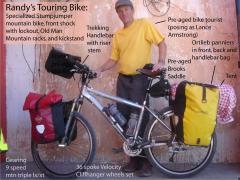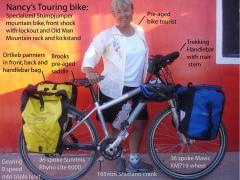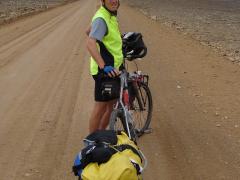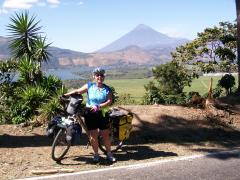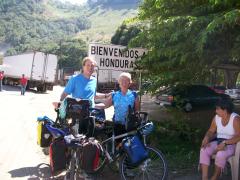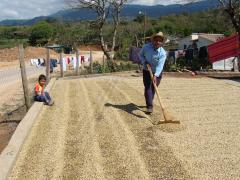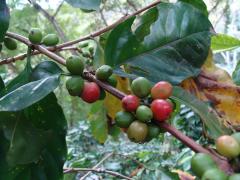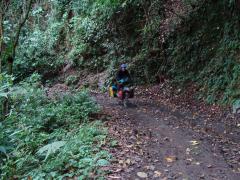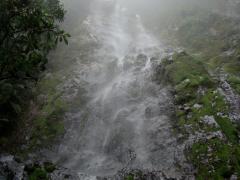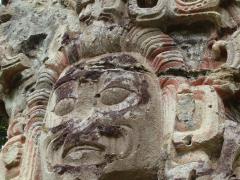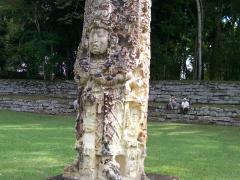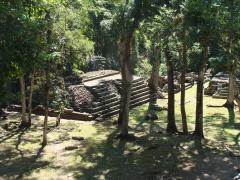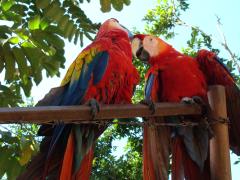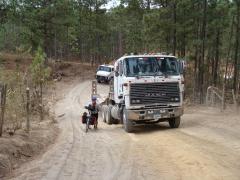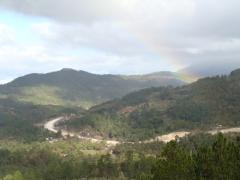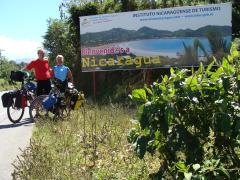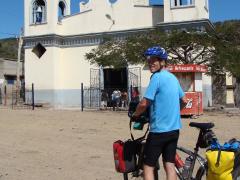Trip Blog
Treats for Geeks, Geography Nuts, and Bike Tourists going to Mexico
You might wonder what we're doing with all this time off here in Palisade, Colorado. Well we intended to be riding and trying to get into shape, but winter has now set in...
But here's what I've been up to . If you're a computer geek or a geography nut or a bike tourist planning to go to Mexico, you'll probably like it. Otherwise you'll think I'm crazy.
Our new Mexico Route Section has the complete and accurate maps of where we went in Mexico, down to daily detail. Each region in Mexico has an overview map with some narrative about our route (how the road was, what the best sights were, etc.) Then at the bottom of each regional map are links to the daily detail, with a map of the day's ride and an elevation profile, and downloads of the .gps and .kml files.
Geography geeks of the world, unite! Thanks to Google Maps for their incredible free services (and the fact that they turned on imagery for Mexico and Central America a few weeks ago).
Enjoy the new Mexico Route Section. And the Guatemala Route Section is ready too... But we have more to do with that one!
New features on hobobiker.com
- The forum is a place for people to discuss our trip or other issues about bike touring or Latin America. To post there you need to (painlessly) create a new account.
- There's now a contact form on the menu that you can use to contact us - it's easier than pasting our email into your email client.
- The "Trip Info" section now gives full geographic information about where we are and where we've been, including maps and gps files.
- If you're using a newer browser like Internet Explorer 7 or Firefox, you'll see pull-down menus at the top of the page. This makes navigation easier and we can use the page more effectively.
How do you like our new banner?
Our bike touring gear
Lots of people ask what bikes we used for the trip, so here they are.
We both used Specialized Stumpjumpers with front shocks, trekking handling bars with extenders, Old Man Mountain racks, Ortlieb panniers, kickstand, wide touring tires from Continental and 36 spoke wheels.
In Peru, Randy switched from panniers to a BOB trailer. See the update and the picture on the right.
We both started out with Brooks saddles but both of us switched to various version of the Terry Liberator Y - we never did get comfortable with the Brooks saddles, despite waiting thousands of miles and the rave recommendations of so many people. Neither one of us use clipless pedals - we just use regular shoes with flat pedals. We always wear a helmet and use a marvellous helmet mounted rear view mirror. We ride with riding shorts for comfort.
We carried a full set of camping gear including tent, sleeping bags, mattress', pillow, silk sheet liners, cooking gear, gas for the cooking stove, ultralight cooking stove, water filter, two cameras, off and on a computer, headlamps, books, writing material. Nancy carried a travel watercolor kit and a block of watercolor paper. And enough clothes to ride and live in for three days. We also have rain gear and sun hats and sun screen. We carry our personal bathing gear including battery operated tooth brushes. And a small first aid kit. Randy has an altimeter to check out the distance and amount of climbing we do each day.
We sometimes (usually) feel we carry to much, so we are always evaluating what is truly required for bicycle touring. And we keep carrying too much. Our gear is made for the long haul and is solid but we are always searching for the right combination of gear. Randy fully loaded bike weighs about 100 pounds and Nancy's about 80 lbs depending how much water and food is required and available services.
Our biggest decision right now is whether we're going to leave the computer at home...
If you have any questions, send us an email or start a discussion forum.
Also, we've started a Bike maintenance log so you can see what experience we've had with the equipment.
And you can see all our "Gear" articles here.
Goodbye to the old and hello to the new. Or where have Randy and Nancy gone to and will they ever ride again?
Hi friends!
Holiday greetings from the Hobobikers.
You may have noticed that we have not posted many stories on hobobiker.com for the last 4 months. In case you have been wondering what we have been up, here is a recap, along with our future plans.
You may have read that at the end of August, Randy and I went home for a two weeks visit with our respected family and to make sure everyone was healthy and doing well. It turns out they were all fine and we where the very sick ones. Whooping cough is a a hideous illness called the "100-day-cough" because it lasts that long (and maybe longer in Randy's case). I started to feel ill in Guatemala a week before coming home and got sicker and sicker while in Colorado. Within two weeks, Randy came down with the same awful cough which was treated with rounds of antibiotics, coughing syrup, and inhalers. Randy even broke a couple of ribs during one of the 1000 coughing fits he has had. We came to the conclusion it would take at least 100 days before we were well enough to travel so we decided to hang out in western Colorado and recuperate.
We bought a used car, bought car insurance, restarted our cell phone contract, got Internet access for the laptop and made arrangement to live in a trailer house normally used as migrant workers housing for workers in the orchards in Palisade, Colorado. We loaded the car up with everything we would need for several months.
I was amazed at how much stuff we needed for two months of living in the United States. After living from our bikes and then going to living in real housing, the difference was shocking. The car was full of bedding supplies, art supplies, cloths, books, electronics. We unloaded all this crap into our bedrooom in a three bedroom trailer, and it hardly all fit. I was totally embarrassed as the two migrant workers who were leaving to return home to Mexico with their one medium size duffel bag watched us bring stuff from the car, trip after trip. Their faces said it all, as we brought in load after load from the car.
While we were in Palisade for the first month, the weather was delightful. We did some riding, hiking, tennis and walking. We still had our violent coughs that peaked during exertion but we figured we had to cough out the toxins one way or the other, regardless if we exercised or not, so we exercised while the weather was good.
The rest of the time was spent in productive pursuits. I painted up a storm. I painted in oils and in watercolors, the landscapes of the orchids, mesas, and valleys of this western colorado visual paradise. You can enjoy some of my latest work on nblewis.com. I also took several painting classes at the Blue Pig Gallery and helped teach English to Spanish speaking adults. I even learned a little Spanish. Randy updated his computer tech skills, and spent hours after hours experimenting with new security tools, program environments, remote access features. He did an update to the warmshowers.org site and setup new geocoding photo and GPS tracking capabilities on our site Hobobiker.com. But most important we got to spend some quality time with Randy's 81-year-old parents who are doing fantastic overall. As with anyone of this age, they have their own worries and concerns which we helped out where we could and of course we also made their lives a little bit more complicated by adding our energy into their lives. We sure hope they like that cordless phone system we setup for them. And yes that new microwave with the turn dial and no digital buttons, was too big so it was returned to the store.
The last month of December has been so cold we have not had the courage to go out and exercise in the cold. It is currently 14 degrees Fahrenheit in the middle of the day. Burr! When are we ever going to get training for the big ride?
In the last two weeks in 2007, we will visit our family for Christmas in California, pack up all the stuff from the bedroom in the bunkhouse, move 90% of our stuff to storage, sell the car, cancel the car insurance, cancel the cell phone and pack our one bag each for our return Guatemala.
I am very excited to know that on Jan. 1st, 2008 we will be back in Guatemala, reunited with our bikes and will be back on the road the first week of the new year. I am not looking forward to the pain we will be in the first couple of weeks as we get back into riding conditions and back on the saddle. Hope you can join us either in person or via your computer. Wish us luck and we wish have a wonderful new New Year.
We're sure happy to have you riding along with us, and looking forward to what comes next.
We are back on the road in Guatemala
We got to Guatemala safe and sound. And took a bus to Antigua. We stayed with new friends, Judy and Gene, in their incredible home for several days until we got started riding again. (Thank you so much Judy and Gene for all the help and the new friendship)
On New Years Eve, we walked around the plaza in Antigua and watched fireworks and listened to a little music. The plaza was beautifully lit with white Christmas lights around the base of all the trees. We felt we were back home. The sounds, the smells, the people, the festive plaza, the incredible climate, yes back home again.
The time we have been in Guatemala, we are getting quality exercise. We climbed a Volcano (Pacaya) where we got so close to flowing lava it almost melted my nylon coat. Incredible to watch lava slough down the lava worms turning the hard rock to molten liquid glowing from the fire from the earth´s core. I was hoping there was no earthquake or eruption while we were so close. It turns out there was a good one several days later. While we were hiking down in the dark, the winds kicked up, trees swayed in the violent wind and the air was thick with ash.
The next day we started out riding with another cyclist, Scot Domergue, who cycled down from Mexico. He met us as planned in Antigua and we will ride together for 3 weeks if he can stand our style of riding. So far we have had a great time and all is going well.
On the first day we only rode 6 miles but we climbed up a few thousand feet. I did have to walk a few spots as not to over stress my legs which are not use to climbing with my load. I guess there is always a price to pay for to much time off, too much Christmas and the amount of wine that I consumed during the Christmas holiday. I thought to my self as I climbed, that this was a no wine zone (no complaining zone)
We took a pickup through a remote dirt road because of reported bandits. We did stop for the evening in Palin because of hurricane force winds that knocked out the water and electricity in pretty much everywhere in the center part of the county.
The next day we rode 45 miles and climbed 3300 feet. It was tiring because it was the 2nd day on a bike in several months. But it so beautiful. We cycled around a Lake Amatitlán where there were banana trees, palm trees and many plants blooming. We ended up riding down to much lower elevations on the Panamerican highway. There was a section on the Panamerican highway that was just like in the United States, 4 lane divided highway, huge shoulder, and very little traffic. We descended 3000 feet in 7 miles. My max speed was around 38 mph and I bet Scott's was closer to 50 mph. In the lower elevation, it was hotter, had little bugs which attacked my bare legs and the vendors all were selling pineapple. This also was the end of the nice wide Panamerican highway. It narrowed to two lanes with no shoulder and lots of traffic with huge trucks. It was the kind of riding that requires heads up and getting off the road to let the big trucks and buses pass. We decided we prefer the back roads so we headed through the northeast central part of Guatemala.
Currently we are in Mataquescuintla. The ride here was of course steep because of the the volcanic terrain, but very scenic. We are riding through the coffee growing area and more forested area then we have seen in other highlands of Guatemala. People continue to beep hello from there cars or bid us good day as we pedal by. Though I am starting to see more cautious stirs and a few people that actually looked scared.
We are staying in a quality hotel -- Hotel San Miguel in Mataquecuintla which has warm water in the shower, TV and a balcony that looks out to the surrounding vista for about $12 a night. It includes toilet paper, towels and soap. We seem to have gotten a cold so we will hang out for a day or two. Meanwhile I am taking care of a little business: getting a new cell phone (our phone number is on the contact page - call us!) my pants shortened for 50 cents by a very tiny old man with foot-powered sewing machines, updating our website for 60 cents an hour, and a hair cut which I have not gotten yet)
Plus I will go get some lunch or almuerzo. The most common lunch is fried chicken and french fries, tacos, or soap with vegies and meat. I am now hungry talking about it so that is all I will write about for now.
Priming our MSR Whisperlite Internationale with Denatured Ethyl Alcohol
This is just a note for other bike tourists and people who travel with their MSR Whisperlite stoves. The wonderful thing about the Whisperlite is that it will burn plain old gasoline. The terrible thing about it is that (if you use the gasoline to prime the stove) it makes a mess every time. You're always dealing with ugly black soot on the stove.
Well, we've started using regular denatured ethyl alcohol to prime the stove, and we never have to clean it, and rarely sense any kind of fumes. Ethyl alcohol has been easy to get in Mexico and Central America - you just go to the drugstore and ask for Alcohol Etílico in a high percentage (88 or 90 grados). It's cheap and wonderful. Our stove is more reliable, but most important, I don't get dirty all the time from it. (And we can surrepticiously run it in a ventilated room because it doesn't make any smells.)
Here is a great writeup on all types of fuels and where you can get them around the world.
Daily Life Back On The Road
We are getting into the groove of riding our bicycles down to the bottom of South America. After 4 months of living in the United States we have giving up that and live the life of Hobobikers. What does this mean?
It means staying in a different place every night. a hotel, a flop house, someone’s house, a backyard, or camping somewhere in a town that someone has claimed is safe. Currently we are staying in hotels, with anywhere from a small twin bed to three various-sized beds. Some have running water all day long and produce warm water through an electrical device attached to the shower head. This is called a suicide shower. Never raise your hand up while washing the armpits and touch the electric device. You will get a shock. Others have water only part of the day because of water shortages in the region.
At the end of the days riding we wash that day’s biking clothes in the sink or shower or perhaps a concrete basin for washing clothes called a pila. We have a stretch clothesline for drying our closes. All the shower floors in Central America are about 8 inches taller then the surrounding floor so when I step out of the shower with wet feet onto the tiled ceramic floors, I always feel like I will slip. I use a red bandana as a rug which I wash in the morning and hang it on the bike to dry during the day.
Dinners are usually some kind of grilled meat or chicken dish with rice and some other side dish. Actually this is also for lunch and also for breakfast. I am getting tired of the same food so I guess I will have to get creative.
We set out in the morning between 6 and 9 depending on the temperature and ride for the day. We only really ride 3 to 5 hours a day but it takes all day long. I have to stop a lot and get off the bike to stretch, make an adjustment or have a quick snack. As we approached Honduras the daytime temperatures seem to be getting hotter so we starting earlier then usual. In really hot weather I will wet down my shirt and bandana and ride with the nice coolness of the wet cloth.
We stop some times for a nap along the side of the road or along the side streets of small villages. Usually kids come up to us in the plazas to ask questions or beg for a coin or two, so if we want a real nap we go where no one else is.
As we ride lots of drivers beep, people say god day and others just stare at the strange site of gringos riding their bikes fully loaded past their doors or pastures or washing in a Pila.
We take photos, talk with those that are interested which seems to be a lot of people, and mostly we ride all day. In the western part of Guatemala we have been climbing up step terrain on paved and unpaved roads so I have been walking up the mountains with my bike. I sometimes do not have the endurance to ride and climb the heights that these areas present. I have been offered rides but I politely decline. I will make it to the top one way or the other. When things are very tough, Randy sometimes will ride ahead, park his bike and walk down to meet me. He will walk my bike up the hill for me. I am not proud of this but sometimes I just need a little extra help. He is so very patient. (thanks honey)
Around 4:00 to 5:00 we will arrive in our evenings destination and I will go find us a hotel that fits my requirements. I am in charge of this task because where we stay matters more to me then to Randy. I like a window that opens to the outside natural light and a halfway decent mattress. Randy would take anything for a great price but I do well (according to me) in finding the best place for the value. We have spent anywhere between 7 dollars and 15 dollars a night for lodging. Randy has not complained once about the places I have chosen
That is a typical day of the hobobikers in Central America. We rest a couple days a week, just like a work week. We are taking a couple days in Copan to enjoy the Mayan ruins of Copan Ruins, Honduras. A very nice place which we recommend. I hear it is the nicest town in Honduras but we have just gotten here so we will let you know later how it compares.
Climbing the Pacaya Volcano
Views from Pacaya Volcano
One of the delightful touristy things you can do in Antigua Guatemala (the beautiful gringo touristy old colonial city just a few minutes from Guatemala City) is you can climb the Pacaya Volcano and see the lava flow there. For $5-$10 you get a bus ride to the trailhead (about 2 hours away by slow bus) and a guided hike up to the lava flow at dusk. What a treat it is! I've never seen a lava flow before, so this was great. We climbed up a steepish trail for perhaps 45 minutes before getting to the cold lava flow we had to cross to where the actual river of lava was flowing. Then we had to slow down considerably and pick our way across the rough black lava. But when we got to the actual lava flow, it was just at dusk, and it glowed terrifically, and it was so much fun to see it squeeze and fill and move around and flow into little lakes.
When I did the exact same thing in 1994 with my young kids, it was a completely different mountain. Then you had to climb up a steep, steep cindercone to get near the crater, where eruptions regularly dropped rocks just a few feet in front of you. A completely different kind of volcano.
You can click on the triangle in the video to view it. You can also view the full sized version at youtube or look at all the videos we've posted.
Entering Honduras, our 5th country!
There are new pictures posted and the route information is up-to-date so you can see our route through Guatemala.
We finally entered the 5th country on our trip, and once again we're sad to leave a delightful place. Guatemala was great to us, if we don't blame it for the whooping cough :-)
We had to pay $1.30 to leave Guatemala and $3 to enter Honduras, but there were no problems of any kind. We even got the exchange rate we asked for when changing our Guatemalan Quetzales into Honduran Lempiras. Lots of friendly talk with everyone around. The border post where we crossed is a bit of a backwater, which helps, I'm sure, but the people sure were good to us.
Just to remember, here are some of the prices we paid in Guatemala:
- Hotel with private bath and hot water: $13
- Street meal of steak in a tortilla (churrasquito) with potatoes and onion: $1.80
- Guatemalan beer (Gallo) in a restaurant: $1.30-2.00
- Internet: $.80/hour
- Standard guatemalan sit-down lunch: $1.30-2.00
- Gallon of purified water: $.80
- Liter of cheap red wine in a box (pretty good - from Chile): $3
- Hire a pickup to take 3 bikes people down a dangerous road 13 kilometers: $30
- Haircut: $1.30
- Medical consultation at a pharmacy: $2.60
- Aralen antimalarial pills: $.15 each (we take 2 per week)
Despite the rather rough things we'd heard about Guatemala, our experience was just meeting lots of nice people who were surprised we were riding our bikes through their territory. I don't think we met a mean person in the country. We did read the newspapers, and like the newspapers in all countries, they reported some ugly things. I can't figure out whether there are more ugly things here than home in Denver, because all the newpapers sell themselves by reporting as much bad stuff as they can. I do think that people here perceive themselves as less secure than people in suburban Denver. In some areas they lock up pretty tight at night. Anyway, we had a delightful time with lots of wonderful people in Guatemala.
But wow, those mountains are big. We climbed far more every day than we would have in the Colorado Rockies, and it was much steeper. This week we climbed from 4500 feet to 8200 feet one day, and then were down at 1500 feet the next. It adds up to pretty steep stuff.
Update: We got over our colds pretty quickly, and Nancy seems to have gotten past her intestinal distress, so we're ready to ride more in Honduras after enjoying a 3-day stay in Copan Ruinas.
Guatemala Reprise: New Pictures and Route Update
Here is a slideshow of the pictures from the last week or two in Guatemala (plus the Copan Ruins in Honduras). You can view all the pictures in full size and with their captions on flickr.
Coffee Harvest
The areas we've been riding through on Guatemala and Honduras are all full-bore into the coffee harvest. Coffee is everywhere, and it's really interesting to see where that brew comes from.
On the picking side, we've met little kids with mayonaise jars and whole families, each with a home-made bucket. They work as hired hands, getting paid about 1 lempira, or 2 cents per pound of picked coffee. A family can pick a fair bit in a day - maybe each of the kids can pick 40 pounds, bringing in US$2.00. This time of the harvest can be the primary cash earning time of many of these campesino families.
We met Carlos, on the complete upper end of the coffee spectrum, at a hot spring in Gracias, Lempira, Honduras. He is a coffee taster, employed by the Guatemalan national coffee testing laboratory, and he helped us understand some of the details about the harvest. He mentioned that US people have a tendency to disapprove of small children being involved in the coffe harvest, but here it's a longstanding tradition, and beneficial to the families. Carlos also explained what makes coffee good (bigger beans, shade grown, mountains, etc.) and what the various grades of coffee are, and how world price fluctuations affect this region (a lot!)The coffee bean off the bush is a largish green thing, which has to have the outer fleshy part ripped off with a machine to leave the inner bean. This step of the harvest is invariably done with a machine. Then the coffee is left out in the sun for three days to dry. We see drying coffee everywhere we go. Sometimes it's on a concrete platform that looks like it's made for the drying, and sometimes it's just out on a plastic sheet by the road.
After it's dry, the grower takes it to a buyer or a cooperative, and somewhere along the way the base price is $1.35 or so a pound right now. That's the international base price. From talking with some of the small farmers along the way, we gather that they get about $1.00 of that for their finished beans.
Then, of course, at some point the coffee is roasted and packaged and you get to drink it at Starbucks. It sure is big business. We did hear about one cooperative of indigenous people in the northern area of Nebaj, Guatemala, who control the whole process, packaging and shipping their own brand of roasted and ground coffee directly to Italy. Their Italian priest helped make the arrangements after people started moving back into the region after the civil war calmed down in the 90's.
La Tigra National Park Cloud Forest
In Central America there is still some remaining cloud forest. In Honduras we had a chance to visit Parque Nacional ¨La Tigra¨ for a couple of days. We took a 3 hour hike up into the high mountains. We walked along the flower lined path up further into the heavens and into the misty rain forest. The thickness of the clouds increased with each meter we climbed. The visibility dropped down to nearly nothing and the silence of the jungle like mountain forest became louder. Up at 1800 meters there are pine trees, flowering hard wood trees, mosses engulf everything. The parasitic bromeliads grow in the branches and grow with vengeance. We climbed to the 100 meter waterfall before calling it quits. We could have climbed another 6 hours but that day was suppose to be a rest day. It was wonderful having the whole rainforest to ourselves, we did not see another person hiking the old mining trails of ¨La Tigra National Park¨.
What was amazing is that we where only 15 Kilometers from Tugucigalpa, the capital of Honduras. It was just over the ridge another couple of thousand meters higher and then down a couple thousand more.
We did see some some birds, no pumas as the name of the park implies but we did see a healthy ecosystem that perhaps is one of the few left in the world. A hundred years ago this part of the park was all old-growth forest, but it was all cut down for a U.S. gold mining operation. And now one hundred years later nature has reclaimed its powerful determination. Nature is amazing and we got to experience it at its best.
We're now just a few days away from the Nicaraguan border, if all goes well.
Copan Ruins in Honduras
Our first stop in Honduras (and one of the reasons we chose the route we did) was the famous Mayan ruins of Copan. We dragged in at the end of another 3-day stretch of riding these mountains (about the best we've been able to do before resting at least a day). Nancy was sick with some kind of stomach thing and we were both finishing off colds. (All of these ailments are long gone now, thankfully.)
So we weren't at our best the next morning when we went to the ruins. We spent the entire morning there, and hired an English-language guide to explain it all. But we were all the time just feeling like we wanted to be in bed or getting something to eat, which is not what you want when you're at one of the world's most famous and important archaeological sites.
Despite our sorry state, we really appreciated the artistic beauty of the place. We've been to several other Meso-American ruins, and the beauty of the stelae (tall stones that tell a story) and other engravings was just off the chart. Somehow they really developed a much more artistic way of doing all the hieroglyphic writing here.
The environs are beautiful green luxuriant growth, like at Palenque, but the structures are considerably smaller.
Probably the most significant thing we've taken away from Copan was the enormous connectedness of the ancient Mesoamerican world. It turns out that Copan's first ruler came here from Teotihuacan in the second or third century of this era. Well, we visited Teotihuacan probably 10 months ago just north of Mexico City, and the thought that these two places that seem so distant to us were so connected is astonishing.
The visit also made us cherish the string of archaelogical treasures that we've been able to visit on the ride - Tula, Teotihuacan, the Plaza Mayor, Monte Alban, Palenque, Copan, and several smaller ones. For the first time we have at least a rudimentary understanding of what they were, when they were, and how they were related. So often sites like this are just a splendor of visions and artifacts, but you can't sort them out in the end, and we seem to have gotten one step beyond that on this trip. Still ahead of us is Macchu Picchu, but that is quite a ways yet.
At Copan we also visited the very nicely done Macaw Mountain, which is set up as a tropical bird park, but is actually an outstanding pet rescue operation. They accept unwanted parrots and macaws and all sorts of birds from all over the place and have them set up in the nicest enclosures you'll find anywhere. We spent hours wandering the park and enjoying the butterflies, including the famous Blue Morpho, that we found there.
Lightening our Load
We're notorious for carrying to much stuff, and somebody at the the hotel in Copan Ruinas must have wanted to help us out. The maid or somebody got deep into our stuff and found our cash stashes and lightened them, got Nancy's nice earrings, and my camera was gone too. It's surprising and a little irritating that we could be cleaned out so well, especially by such seemingly nice people. Being rich gringos, such an event is discouraging but not devastating, but it niggles at you when you're the trusting sort. We're acting less trusting when staying at hotels now... Our confidence is just a little shaken. And we'll have to improve our routine a bit. (I do have to add that we let the management know about the problem, and they responded by investigating it, and even offered to reimburse us partially. We did not ask them to do that, but it was certainly a show of good faith.)
Banking in Honduras
People often ask us how we get money for our daily travels. For the last year and one half we have been able to get money from an ATM using a debit card. While there is not one in every town through out Central America we have been able to plan ahead and get enough money for a week or two or more of travel. Sometimes I feel awkward because I can just go into one of the ATM booths, bypassing the long lines waiting to go into the bank. I just go into one of the private booths, slip my plastic card into a machine and get a couple hundred dollars worth if the local currency.
This is how we have been able get our money until we reached. Gracias, Honduras. We miscalculated our available Lempiras, the Honduran currency, partly due to a hotel clerk in Copan Ruinas going through our bags as we explored the area and removing a few things from our bag including our stashed reserve. We we did not notice the cash being gone until we got low on money. So of course we go looking for an ATM which turned out to be non-existent in the town of Gracias. I went to all three banks to see if I could use my debit card as a Visa and with draw money. It turned out I could at one bank but the system was down and I needed to come back two hours later. I was curious to see I could use my debit card at another bank and since I had a couple of hours to wait anyway I gave it a shot.
What I found at the other bank which is true of all the banks is there is always one or two uniformed guards standing at the entrance with guns that look like sawed-off shotguns. I was asked upon entering if I had a cell phone which I did not. There are two separate lines. The first type of line is labeled to be used by those person who are older then 60, the pregnant and the disabled. The other type of line is for all the other people. Well the shortest line was the first so I queued up there. I had plenty of tine to wait and I amused my self that the other people would have to figure out if I was older then 60, pregnant or disabled. Or perhaps I was all of the above. I justified my standing in the shorter line as thinking that the teller would be more compassionate to my broken Spanish and that qualified me for being disabled. But I do have tinges of gray hair so they would not not how old I am. I an a foreigner with light complexion and perhaps we all look the same, yet my stomach has been upset for a couple of weeks perhaps I am pregnant. I had plenty of time to think this over as I stood in that stupid line. But when I finally got up to the teller she said that they bank had no system to help me and sent me to the only bank in town that had one. I still had 45 minutes to wait until the system was back online at the other bank. I had indeed been in the right line.
At the appointed time I returned to Banco Atlantica to withdraw Lempiras with my plastic card. The bank manager took care of me in a matter of minutes. The charge to my bank account happened within 5 minutes of when I entered the door, past the guards with the guns and into the special office with the credit card reader. I was so excited how fast this all happened. This was the good news. The bad news is I had to go stand in the only line in this bank, the one for the cashier. They even had a sign above one of the tellers that said it was for the old, the pregnant and the disabled but this bank just ignored that formality and all people were created equal.
So I stood in line for 45 minutes trying to entertain myself. I noticed that the fatter ladies brought their children with them so the children stood in line for them while they sat in the chairs along the wall. The lady in front of me must have no children at this time so she just went and sat down. When we got close to the teller she just got back in her place in front of me. How did she know I would hold her place? She did not even ask but I guess I have one of those faces that she knew she could pull this and I would let her resume her place in line.
As I finally got got close to my turn with bank teller, the system went down. Oh, this was bad news. The bank closed in ten minutes and every one was getting anxious. The atnosphere in the bank had changed. The few remaining people in front of me wanted to deposit their money. The women started taking out their money hidden in their brassieres and trying to get a place in front of a teller. They needed to deposit their money. As for me, I also wanted my money that had already been charged to my account. I did not know what I would have done if they said no system, no money. But I got my money and headed back to the hotel with a story of how complicated getting money out of banks can be if there is no ATM machines,.
We are luck in so many areas. We have enough money to have an ATM card. We do not have to stand in long lines and wait to be processed. Having resources is a grand thing. As I travel, I learn that life is very different for people in so many ways. So the next time you get cash out of a machine or go to a teller when you have to wait 2 minutes think of all the people that have to wait hours in one day to be able to do their banking.
Route through Honduras
You may remember our friend Tim Malloch that we met in the north of Mexico, in the Copper Canyon region. He was headed north, and we south, and like all travelers we meet, we pestered him with lots of questions about his route and his favorite places along it. We remembered him telling us that the back roads from Santa Rosa de Copan to La Esperanza were his favorite section in all of Central America. So we set out to follow his route. We suspected, but didn't know, that it would continue the really tough mountainous route that we'd already been struggling with in Guatemala. But we took it, and he was right, it was delightful. We spent several days with nearly no traffic, delightful pine-covered hills, and interesting people tucked back in remote valleys. We passed by little roof-tile making operations (apparently the clay is good in this area) and climbed through some of the most remote areas we've been in since northern Mexico. In one town we found no available hotel or "hospedaje" (cheap hospitality) but the mayor happily opened up the municipal offices and settled us in the community meeting room. We had all the comforts of life including a bathroom and a cold shower (which was one of the lesser cold showers we've had). All gratis, thanks to the kind mayor and town of San Miguelcito.
After finding our way through the beautiful country we had one more day of really nice riding before we landed at Honduras' main north-south highway, and it turned out to be so beautiful. Some kind of weather system moved in and we spent half our day climbing a pass in complete dense clouds, passing vegetation-rich creeks that flow out of a major forest reserve. We could hardly see anything, but we imagined what was behind those beautiful creeks coming out of the pine forests. (We're seeing our last pine forests in the next couple of weeks, because they don't grow any farther south than Nicaragua.)
When we did hit the main highway it was a bit of a shock. All that traffic. We did OK, because there was a fair shoulder. There were just two problems: We were exhausted, and the shoulder was kind of a string of huge potholes. So it was great to have a shoulder, but you had to constantly surf it in and out, going back onto the highway or dropping off to the right of the whole road.
When we got to the first of the big climbs headed up toward Tegucigalpa, we just sat and looked at it and could not summon the courage to start up with our fatigued legs. We ended up gatting on a bus with the bikes "just to go to the top of the first hill" but ended up staying on right into Tegucigalpa, the capital, about 35 miles. We had debated a lot about whether to ride into "Tegus", as it's called, as many cyclists have described it as a nightmare, so staying on the bus right into town resolved our discussion.
We are making some progress at getting back in shape. It's pretty rugged go to come back here after 4-6 months (and being sick at that) and hit these mountains that tax us nearly every day. But perhaps it's the quickest way to get back into it. The good news is that we're up in the high country where the climate is pleasant, especially in the early morning. The bad news is that it's mountain after mountain, and we tire easily.
I have to admit it's a little discouraging to find ourselves going 30 miles and being worn out. But perhaps we'll get back in shape, and maybe we'll be able to get farther in a day once we get to some of the lowlands that we think lie ahead of us in Nicaragua.
Crossed into Nicaragua today
We crossed into Nicaragua today - our 6th country on the trip. We had no problems at all, and all the officials were very friendly. Once again, we even got a fair rate of exchange from the moneychanger. We now have Nicaraguan Córdobas, which about about 18 to the dollar, instead of Honduran Lempiras, which are about 19 to the dollar.
Impressions of Nicaragua
What a delightful surprise Nicaragua has been to ride in. From the moment we crossed the border from Honduras into Nicaragua, biking through a country which is the poorest in Central America has been a great experience. Yes we see some very sad sights, houses made of mostly discarded scraps of plastic, lumber, tin and natural products, children without shoes, communities with no electricity, shared wells and old people begging for money. But mostly we find a land with a many different aspects.
We ride up through dry mountain regions on remote dirt roads and everyone tells us we will have no troubles, that we´ll have no security problems because we are outside the urban areas. What we have found is whole communities come out to see the Gringos on bikes riding through their neighborhood, children yelling out hello, good afternoon or by practicing the few words of English they know. Many children near the border would ask for money, the only word they knew. Randy gave a few of the children in Honduras a lecture about asking for money and how it was impolite not to say hello as a friend, but none of the children in Nicaragua have been like that. We learn a lot as we ride through the different parts of Central America.
Some of the steep mountain areas cause us to rest more and to walk our bikes up the steep grades. We have had a chance to walk with more people or ride along a campesino on a horse. I think Nicaragua has more people walking, riding a bike or a horse in the countryside then we have seen elsewhere.
The Valley near San Marcos outside of Esteli
We woke up rather late on Wednesday morning (6:00am) and decided we did have enough energy to take on the 40 mile tough ride from Estelí to Jinotega, all on dirt. We saw maybe 10 to 20 vehicles on the remote Nicaragua back road which were mostly buses serving the local communities, The landscape was mostly dry desert and rolling hills; other areas along the way were highly productive river valleys were tobacco, onions, cabbage, potatoes where being harvested.
We stopped at a small tienda in the middle of the trip to purchase a cold drink. There we meet many local residents including Sarah, a Peace Corps volunteer, who lives in a rented brick house across from the store. We knocked on her door to say hello and a small petite dark haired, young 20ish female came out and greeted us. She was the famous local gringa. We spent sometime with Sarita learning about her life in the middle of rural Nicaragua as a Peace Corp volunteer.
The house Sarah lives in is owned by a young man who has left to work in the United States so she rents it from his family. The house has electricity which was installed in the area a year ago by the government of Nicaragua. She does not have running water but gets water from the neighbor´s hand operated water pump. She washes her clothes river nearby. Since Sarah does not have a refrigerator she stores perishables in the neighbors refrigerator, the rich ones in the neighborhood. Sarah has a outhouse in the back yard, which is just about full and will need moving soon. She cooks on a camping stove which burns propane gas. Her kitchen floor in earthen but her main room which her living areas and bedroom has a concrete floor compliments of Margarita, the previous Peace Corp volunteer.
Sarah has been here for two months and has spent the time getting to know the hundred or so families in the area. Sometime soon she hopes to start a small plot gardening project in the community so they can supplement their diet with fresh vegatables to cut down on the malnutrition rate in the community. The community has a river running through it which has water all year long so she hopes to get the gardening project going and perhaps a tree farm started to help reforest the areas. Most people cook by wood and still continue to chop down the shrinking forest in the surrounding hills.
Asked if she gets lonely she replies yes but once a week she goes to the nearby city of Estelí to meet with the other Peace Corp volunteers who work in this area. This weekend she will go and watch the Super Bowl, not that she really is a football fan but she sure enjoys the company.
The ride from San Marcos to Jinotega
Let me take a moment and tell you about one of the villages we rode through on the way from Estelí to Jinotega, Nicaragua this week. San Marcos is a strange little village where everything has been built around a lone church. The houses in the village form a huge empty dirt circular void around the church with nothing in between. It reminded me of an old ghost town but there was people in front of every house, just sitting and watching the strange gringos ride through their village.
It was around high noon as we rode in. In the bell tower were two young boys ringing the church bell, calling to everyone that the funeral service was about to begin. The only restaurant closed up just seconds before we rode up (probably because of the funeral). Everyone was strolling toward the church and those that were not just sat and stared at us, hungry we rode on to another part of the village that had promise for lunch time nourishment and knowing that we had some hard climbs ahead. With just a small printed sign above a door, I stopped to ask where we could find something to eat. An older man rushed off to find his aging wife. Bingo, there was some food on the stove which they would gladly serve us. We still do not know if this was an official place that served food but they did for us. They were first concerned that we would not like the food they had to offer- beans, squash cooked in the beans and corn tortillas and some kind of milky fruit like drink. We assured them we eat everything, several times. (It turned out that the only gringos they´d ever met were Peace Corps volunteers who were vegetarians and not too thrilled with the local food.) As we ate, we had 20 or so people come visit us. The younger children sat next to us, the teenagers peered in the windows and our host sat and talked about their lives in San Marco.
On the wall above our host where photos of the presidents and leaders that they had respect for including the famous dictator Somoza and many faded reproductions of Christ. They lived here for ever and now 39 grandchildren which many where sitting right next to us. Lunch was great, she asked 30 Cordobas for the meals, about $1.50 was well appreciated by us as we had a steep 1500 foot climb ahead of us. It took over 4 hours to climb and walk before we reached the pavement.
We finally made it to the pavement with an hour left before sunset and still had 10 miles to go to get to Jinotega. The road was a cyclist´s dream. Smooth aspalt, large shoulder, little traffic which drove real slow, lots of people walking and biking and slightly down hill. We made it to town with time to find a hotel before the sunset. The first one had no room, I think it was one of the famous love hotels and that no one spends a full night there. They recommended the Hotel Central down the street. We checked in before the sun had really gone away. Oh it was a great day of bike touring in Central America.

